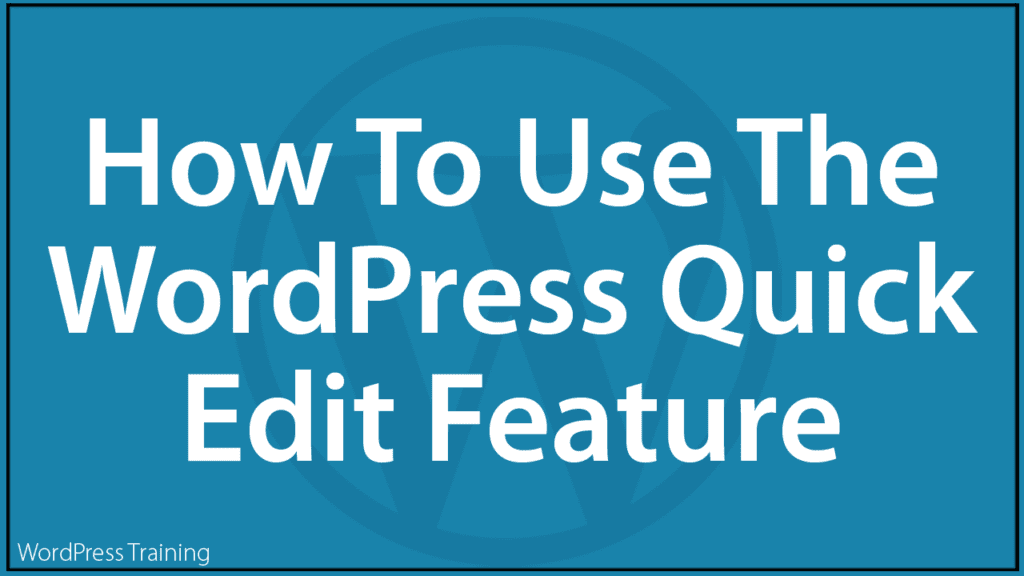How To Use The WordPress Quick Edit Feature
 In this tutorial, you will learn how to use the WordPress Quick Edit inline editor to quickly edit your Post/Page information and settings.
In this tutorial, you will learn how to use the WordPress Quick Edit inline editor to quickly edit your Post/Page information and settings.
If you need help editing and deleting Posts and Pages in WordPress, see the tutorials below:
WordPress Quick Edit – Overview
WordPress doesn’t just store the content of your Posts and Pages in its database, it also stores the following information and settings about your posts and pages:
- Post/Page Title
- Slug (the words that display in the post/page URL)
- Post/Page publishing date
- Post/Page Author
- Post/Page Status (e.g. Draft, Pending Review, Private, Published, etc.)
- Post/Page Privacy Settings (e.g. Password-protected, Private)
- Post Categories and Tags
- Post/Page allow comments enabled/disabled
- Page Order number
- etc.
If you would like to modify any of the above settings for a post or page (not the actual content), then you don’t need to open the post or page itself.
Just use the Quick Edit feature of WordPress.

How To Use The WordPress Quick Edit Feature To Edit Post Settings
To modify post settings using the Quick Edit feature, log into your WordPress admin and select Posts > All Posts from the main menu.
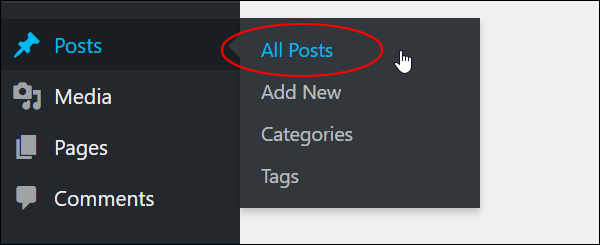
This brings up the Posts screen a list of all your posts.
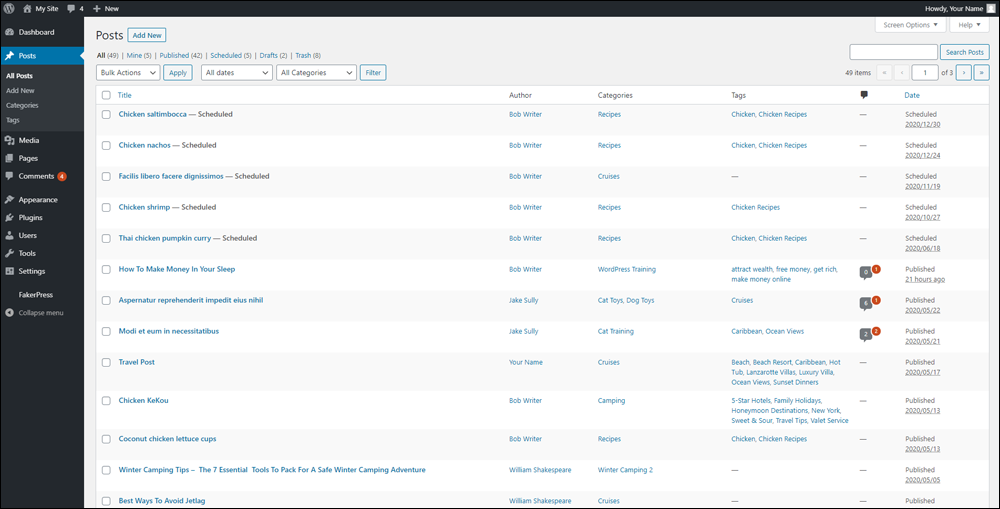
Locate the post you would like to modify, then hover over the post title to view the options menu and click on the ‘Quick Edit’ link.
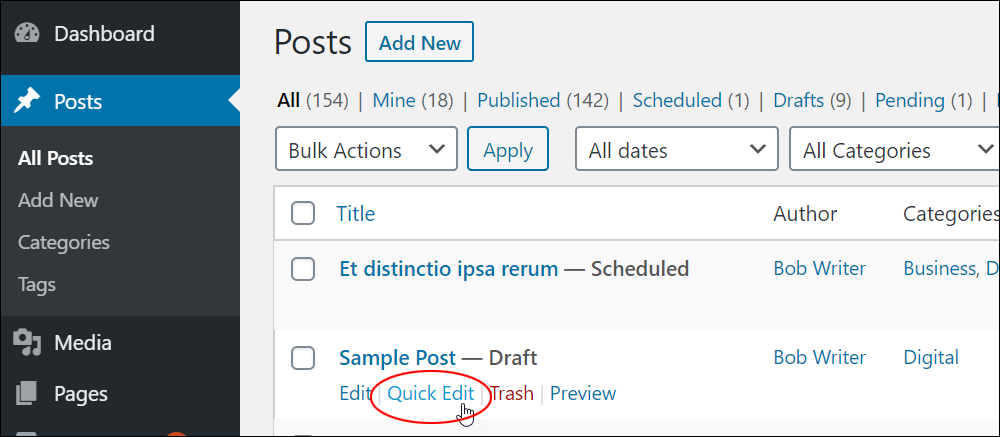
The Quick Edit inline editor expands below the post title and displays the following options for editing information about your posts:

Quick Edit – Post Options
[1] Title – Use this field to edit your post title. Note: You can have a different post title than the URL of your post (which is controlled by the post slug – see below).
[2] Slug – Use this field to modify your post slug and change the URL of your post.
Notes:
- When editing post slugs, use letters and numbers only (e.g.”a-z” and “0-9”). WordPress removes symbols from the slug.
- Separate words with hyphens (e.g. “like-this-example-url”).
- WordPress automatically converts all letters to lowercase and adds hyphens to spaces between words.
- WordPress will automatically create a slug for your post if you leave this field blank.

![]()
If you change the post slug (or plan to change several post URLs), you may need to add a redirection tool to prevent visitors from experiencing error pages if they click on links pointing to the old post URL.
[3] Date – This field lets you edit the date and time of your post.
Note: You can schedule your post to publish at a later date using this feature. To learn more, see this tutorial: How To Schedule Posts In WordPress
[4] Author – If your site has multiple post authors, you can use the Author dropdown menu to assign a different author to your post.
Note: If your site contains only one author, this option will not display in the Quick Edit screen. For more information about changing post authors, go here: How To Change Post Authors In WordPress
[5] Password -OR- Private – This section lets you password-protect your Post or make it private (hidden from visitors).
For more information about protecting content in WordPress, see this tutorial: How To Protect Your Content In WordPress Posts & Pages
[6] Categories – Use this field to add or change your post categories.
Note: Quick Edit lets you add and change post categories, but you cannot delete categories via the inline editor.
To learn how to add, edit, and delete post categories in WordPress, see this tutorial: How To Use Categories In WordPress
[7] Tags – Use this field to edit your post tags.
To learn how to add, edit, and delete post tags in WordPress, see this tutorial: How To Use Tags In WordPress
[8] Allow Comments / Allow Pings – Check/uncheck the boxes in this section to allow/disallow comments/pinging on your posts.
To learn more about using comments and pings in WordPress, see this tutorial: How To Manage Comments In WordPress
[9] Status – Use the dropdown menu to change your Post Status (Published, Pending Review, Draft).
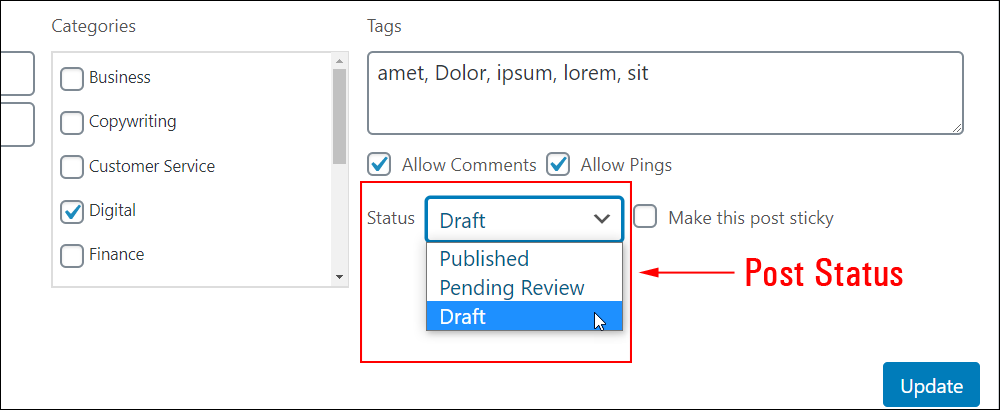
[10] Make this post sticky – Check or uncheck the box in this section to make your post ‘sticky’.
Learn more about using this feature here: How To Create Sticky Posts In WordPress
[11] Cancel Button – Click this button to cancel your post information edits and leave any changes unsaved.
[12] Update Button – Click this button to save your changes and update your post settings.
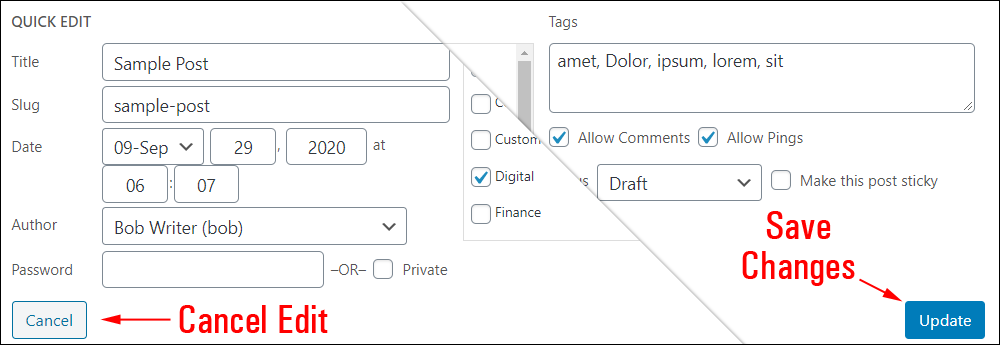
Bulk Editing Post Settings Using The Quick Edit Feature
In addition to making changes to posts individually, you can also bulk edit post settings using the Quick Edit feature.
To make bulk changes to posts using the inline editor, select the posts you would like to edit ticking their checkboxes in your table of posts, then choose ‘Edit’ from the ‘Bulk Actions’ drop-down menu and click the ‘Apply’ button.
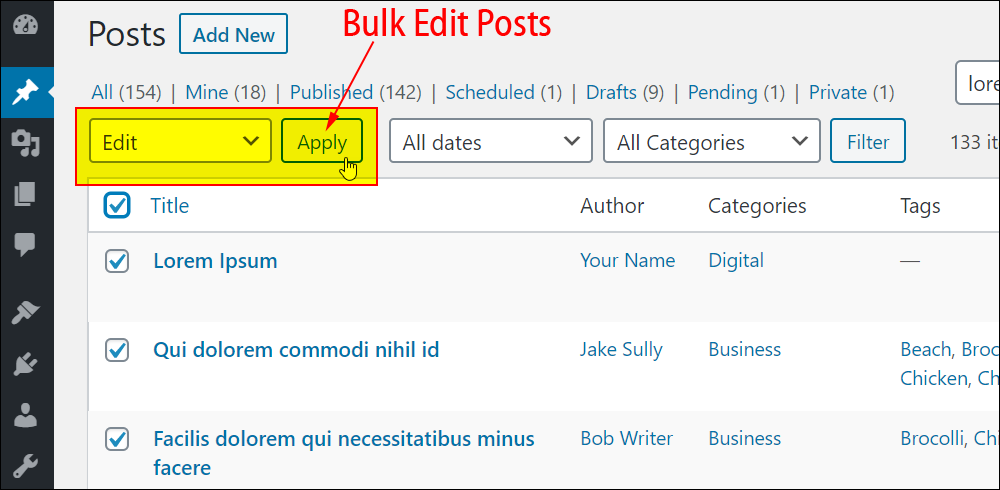
The Bulk Edit inline editor will expand and display the bulk editing options for your posts.

Most of the bulk edit options you will see on this screen are the same as the Quick Edit screen with some minor differences.
For example, depending on your active WordPress theme, you may or may not see a Format option. If this option displays in your Bulk Edit screen, use the dropdown menu to change the format of your posts (e.g. Standard, Aside, Image, Video, Audio, Quote, Link, Gallery, etc.)
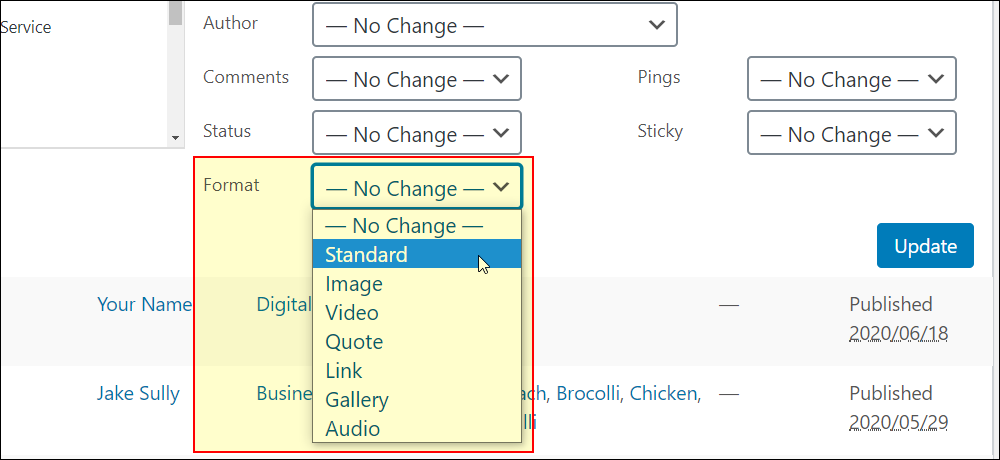
For a detailed tutorial on WordPress post formats, go here: WordPress Post Formats Explained
You can also remove selected posts from the bulk editor screen by clicking on the delete icon next to the post title.
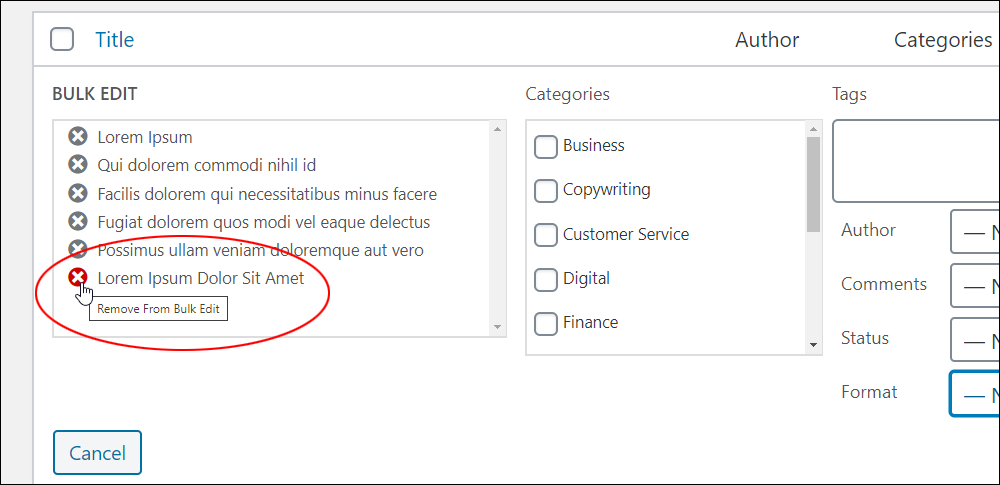
Now that we’ve looked at using the Quick Edit feature with posts, let’s take a look at using the inline editor to edit information about your Pages.
How To Use The WordPress Quick Edit Feature To Edit Page Settings
![]()
WordPress Posts and Pages share similar features, but there are some differences.
To learn about these differences, see this tutorial: WordPress Posts vs WordPress Pages Explained
In your WordPress menu, select Pages > All Pages.
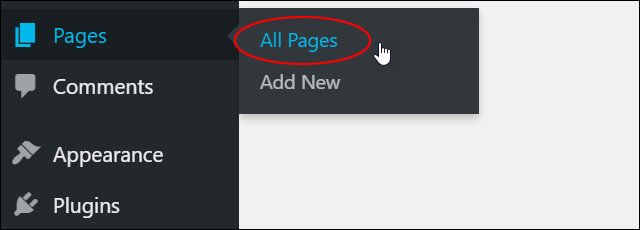
This brings up your Pages screen with the Table of Pages.
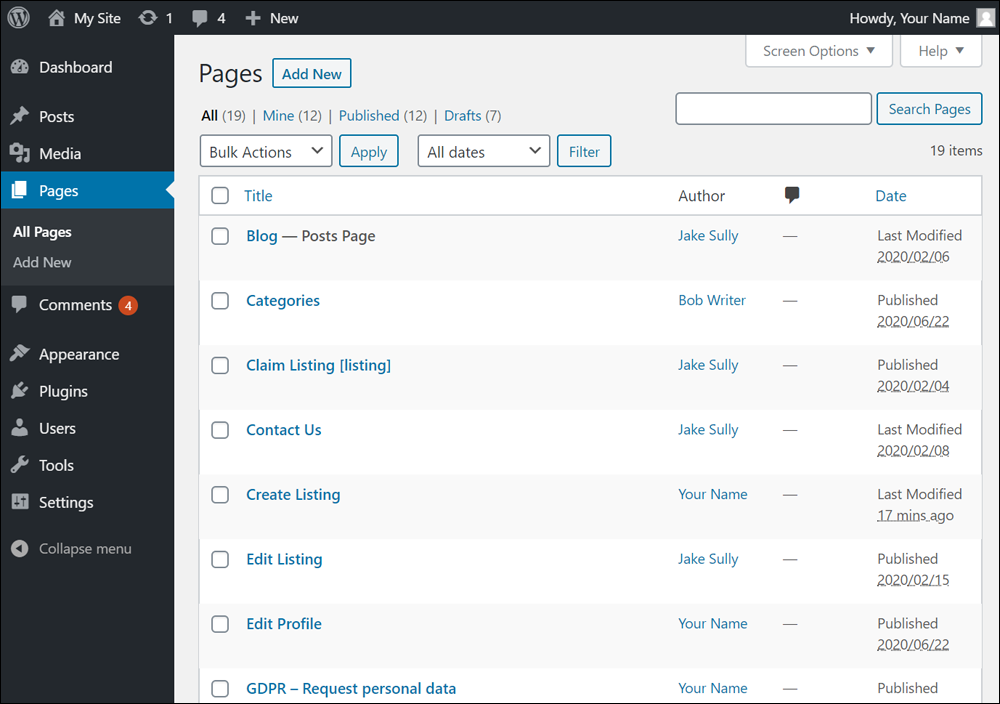
Find the page that you would like to edit information about, then hover over the page title to view the options menu and click on the ‘Quick Edit’ link.
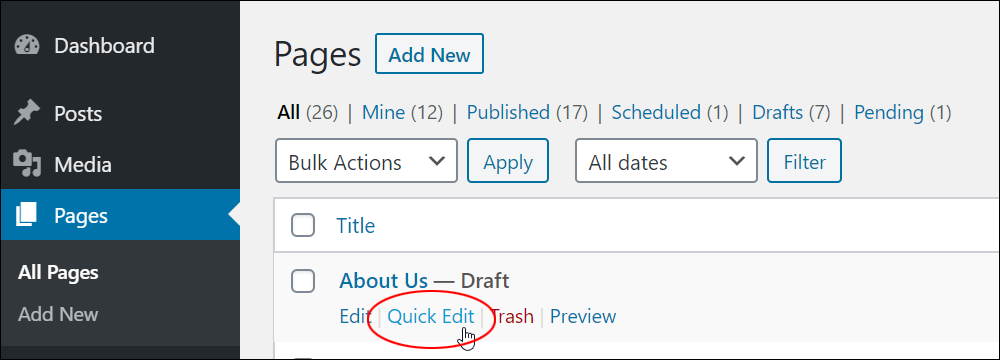
The inline editor will expand and display your page editing options.

Here, you can edit the following information about your page:

[1] Title – Edit your page title. (Same as Post)
[2] Slug – Edit your page slug. (Same as Post)
[3] Date – Edit your Page’s date and time settings. (Same as Post)
[4] Author – If your site has multiple page authors, use the Author dropdown menu to assign a different author to your selected page. (Same as Post)
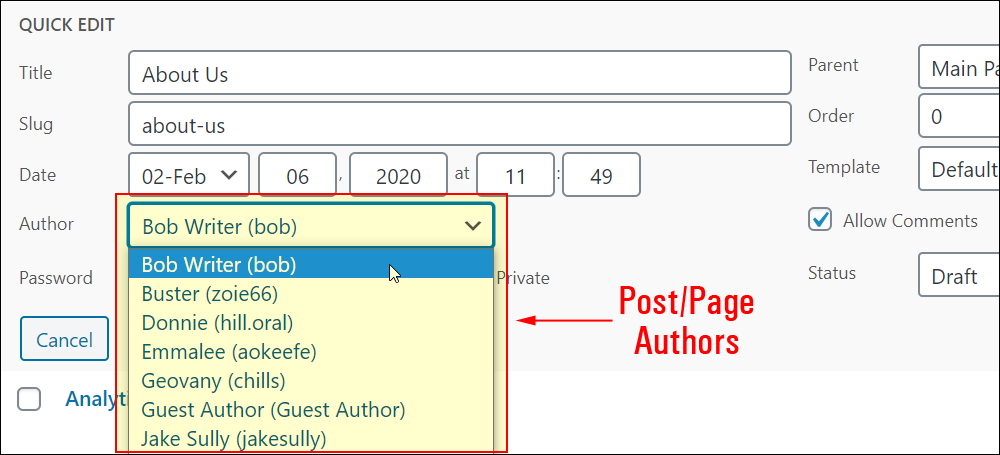
Note: If your site only has one author, this option will not display.
[5] Password -OR- Private – Use this section to password-protect your page or make it private and hidden from visitors. (Same as Post)
[6] Parent – Use the dropdown menu to set your page as a ‘main’ page (displays as a top-level page) or the ‘child’ page (subpage) of another page or subpage (see image below).
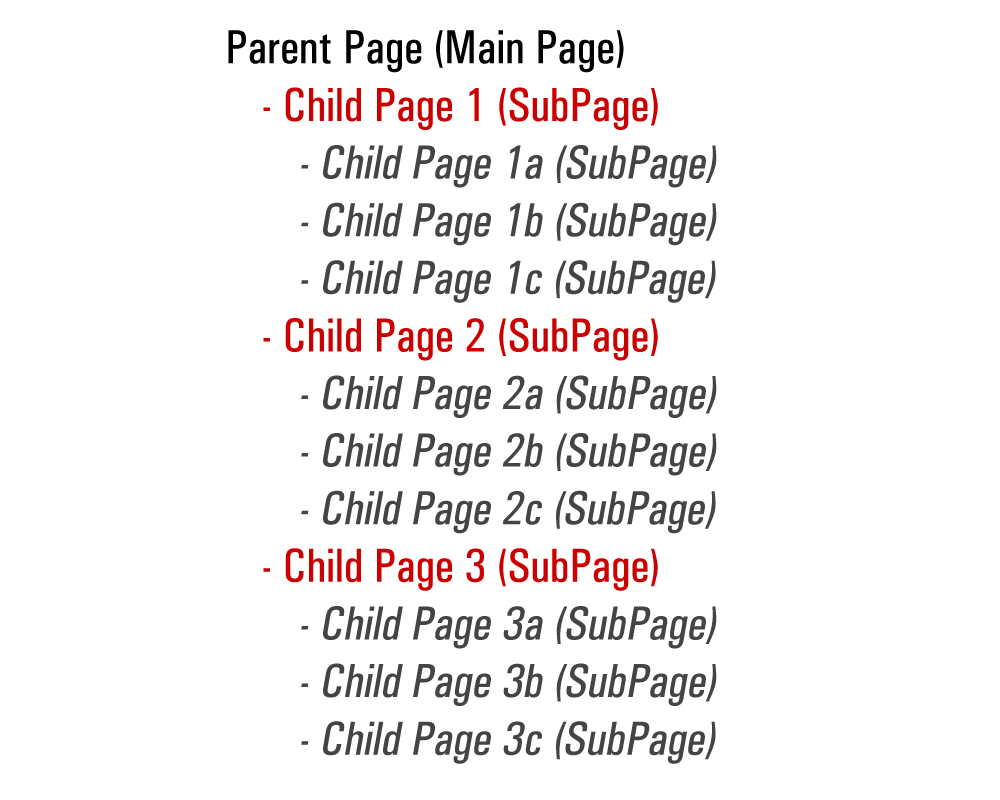
[7] Order – Use this function to order and reorder your pages. This affects how pages display in page lists, menus, etc.
Note: Enter a numerical value into this field. For example, a page assigned a value of “1” will display before a page with a value of “2”.
[8] Template – If your theme includes different page templates, you can change it here by selecting a new one using the dropdown menu.
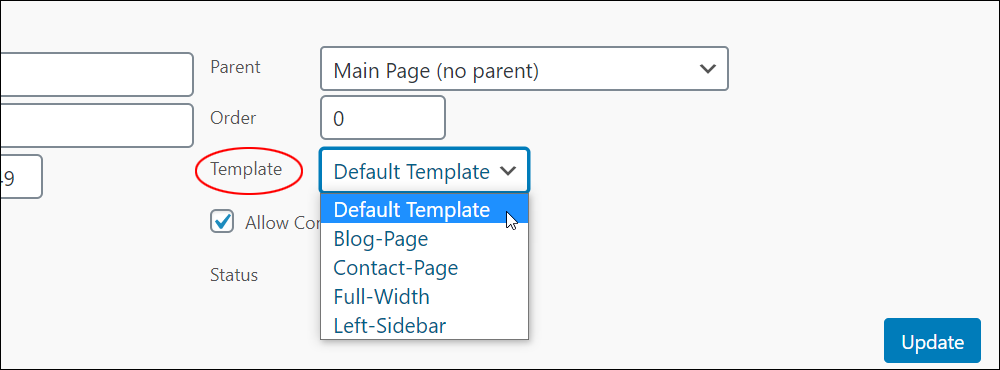
[9] Allow Comments – Check/uncheck the box in this section to allow/disallow comments on your Page.
[10] Status – Use the dropdown menu to change your Page Status (Published, Pending Review, Draft, etc.)
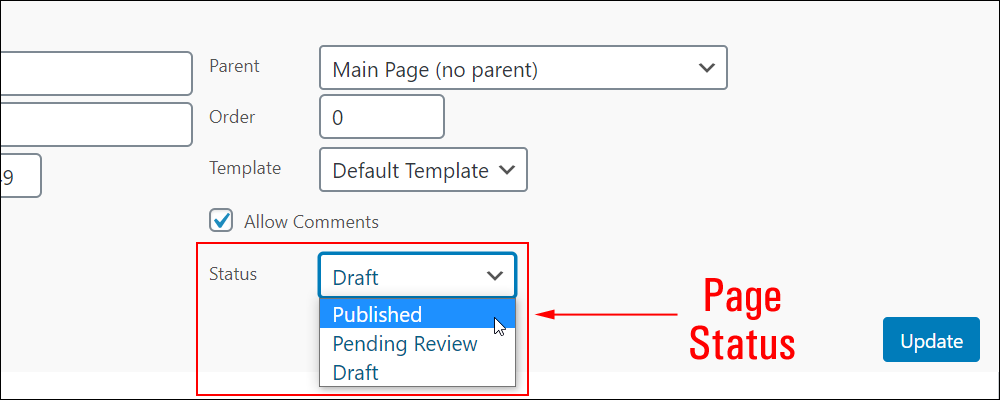
[11] Cancel Button – Click this button to cancel your page information edits and leave any changes unsaved.
[12] Update Button – Click this button to save your changes and update your page settings.
Bulk Editing Page Settings Using The Quick Edit Feature
In addition to editing pages individually, you can also make bulk changes to page settings using the Quick Edit feature.
To make bulk changes to pages using the inline editor, select the pages you would like to edit ticking their checkboxes in your table of pages, then choose ‘Edit’ from the ‘Bulk Actions’ drop-down menu and click the ‘Apply’ button.
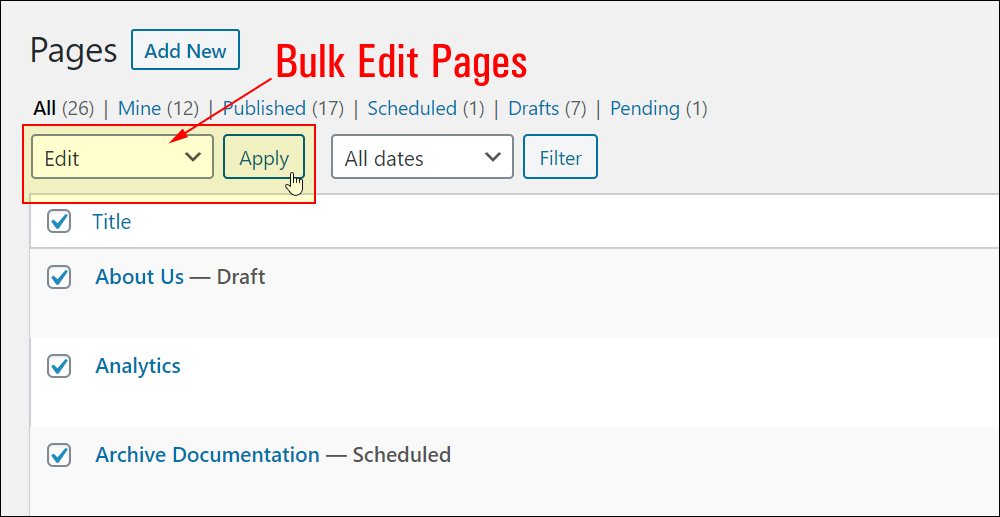
The inline editor will expand and display your page editing options.
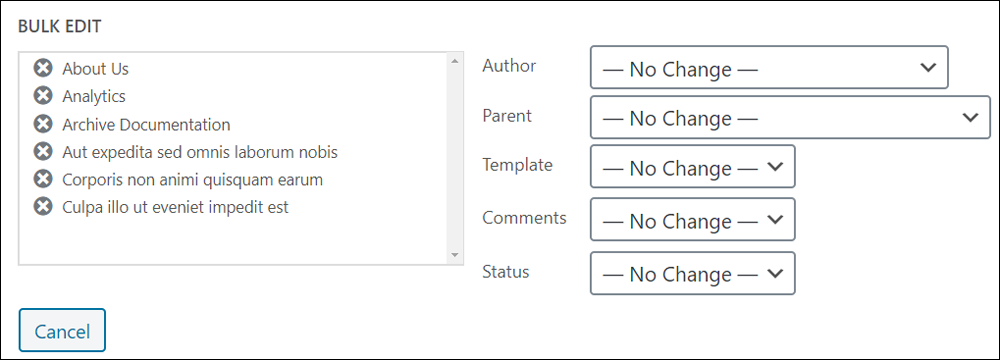
Most of the bulk edit options you will see on this screen are the same as the Quick Edit screen with some minor differences.
For example, the Comments feature changes from a checkbox to a dropdown menu.
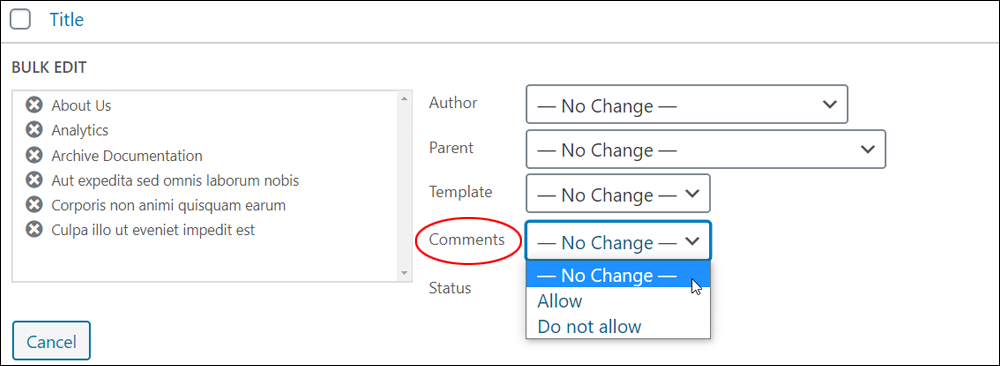
Make bulk changes to your page settings by selecting options from the dropdown menus.
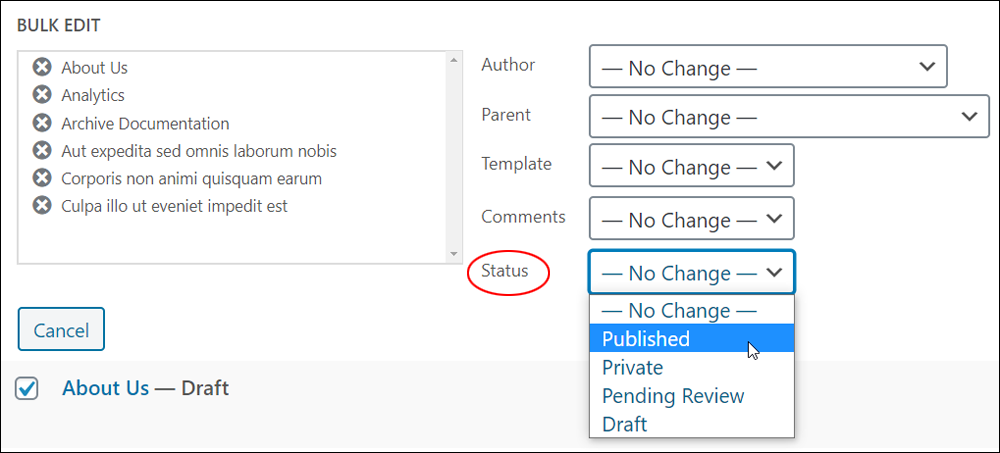
You can also remove any pages from the Bulk Editor by clicking the remove icon next to their title.
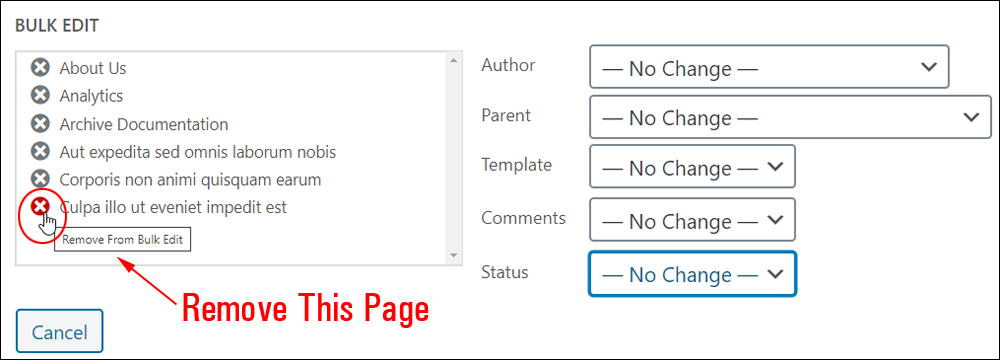
Customizing The Quick Editor With Plugins
You can customize the Quick Edit and Bulk Editor using plugins.
Here, for example, is a plugin you can use to customize the Quick editor and Bulk editor features:
Custom Bulk/Quick Edit
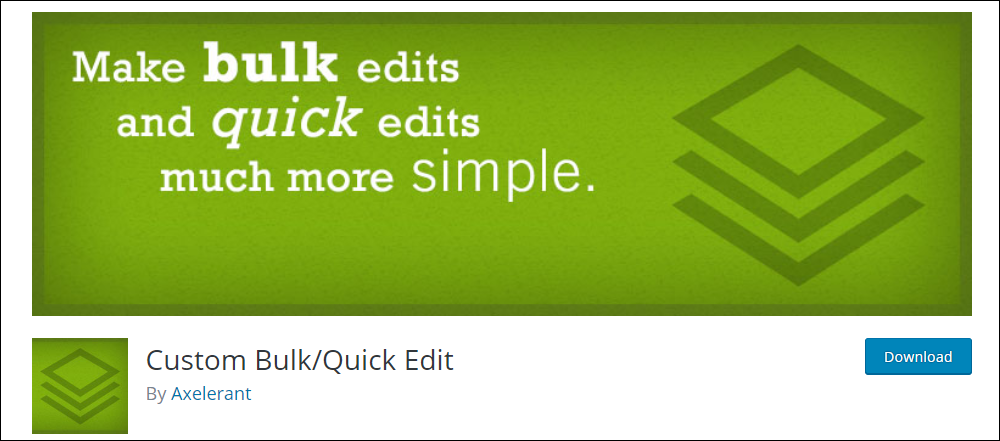
The Custom Bulk/Quick Edit plugin lets you add additional custom options to your post and page Bulk/Quick Edit features.
You can search and install the plugin directly from your admin area (search for keywords like Quick Edit, Bulk Edit, Inline editor, etc.).
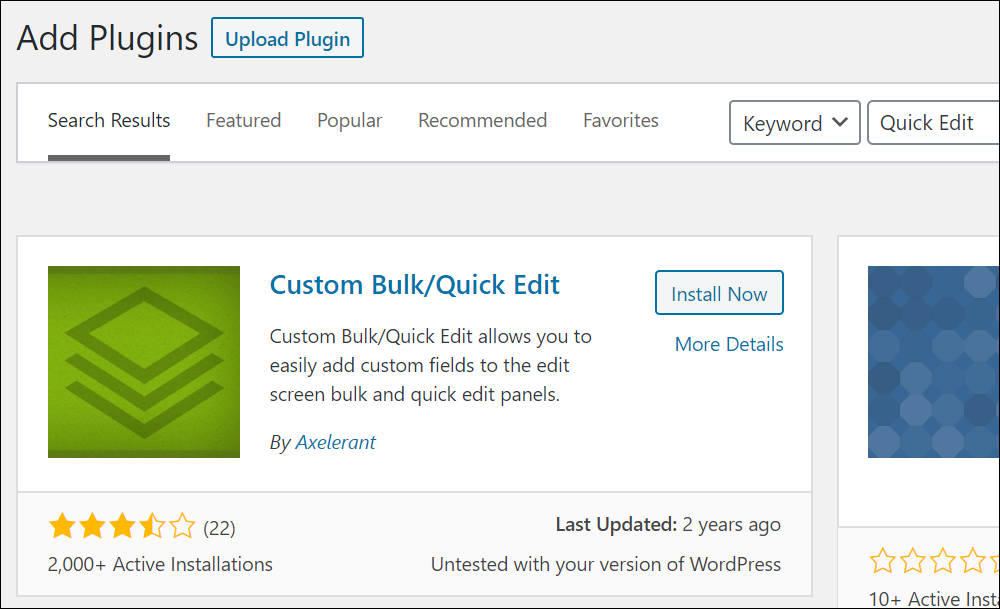
After installing and activating the plugin, click on Settings.

This brings you to the Custom Bulk/Quick Edit Settings screen. Navigate and go through the tabs to configure the plugin’s settings.
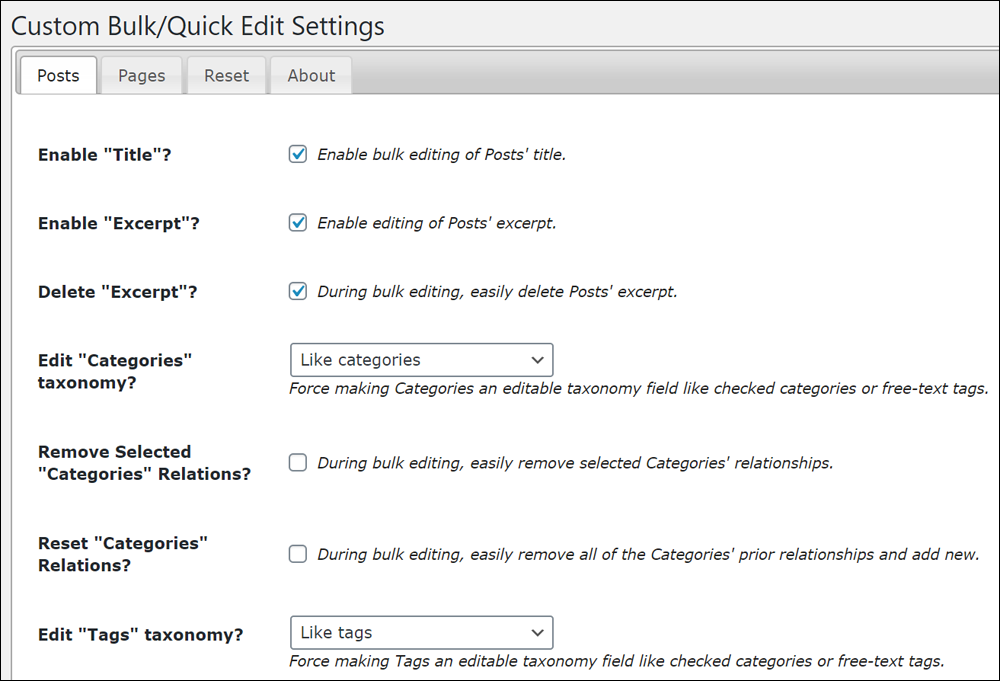
After configuring the plugin’s settings, you should see new custom edit fields display in your Bulk/Quick Edit screens.
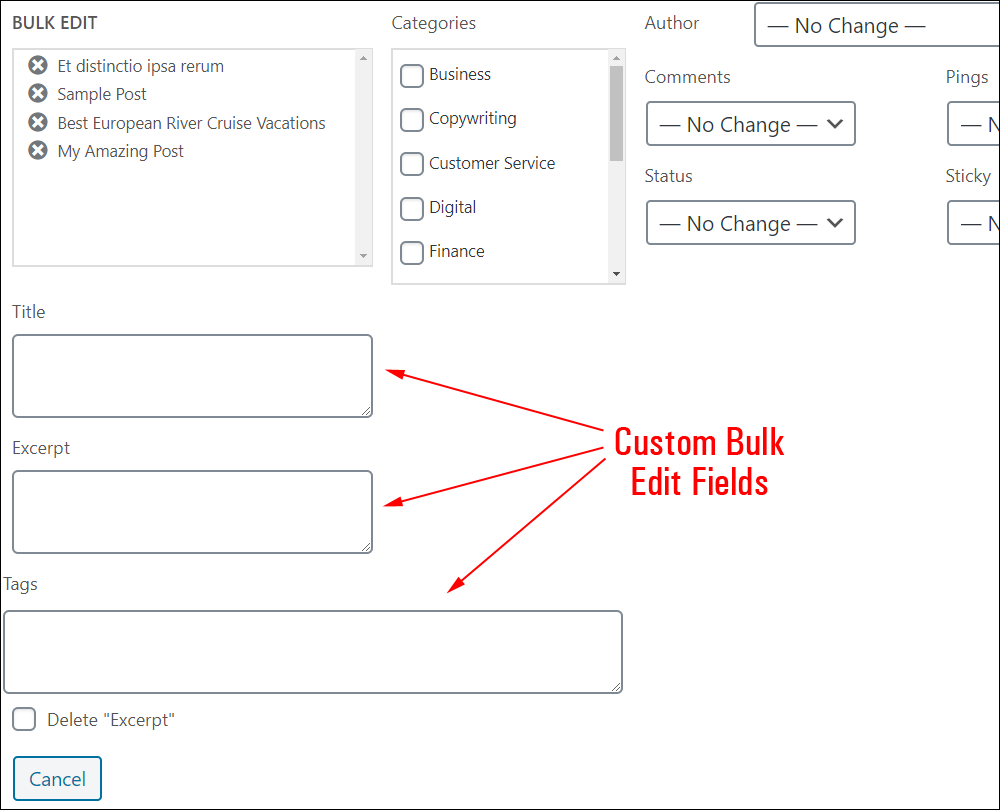
![]()
Note: When we last checked, this plugin hasn’t been updated for a while, but we’ve installed and tested it and it works fine.
To download or learn more about this plugin, go here: Custom Bulk/Quick Edit Plugin
WordPress Quick Edit – FAQs
Here are frequently asked questions about the WordPress quick edit feature:
What is the WordPress quick edit feature?
The WordPress quick edit feature allows users to make basic edits to posts and pages directly from the Posts or Pages screen in the WordPress admin dashboard. It offers a convenient way to modify essential details without opening each individual post or page.
How do I access the quick edit feature in WordPress?
To access the quick edit feature, navigate to the Posts or Pages screen in the WordPress admin dashboard. Hover over the post or page you want to edit, and then click on the “Quick Edit” option beneath the post or page title.
What can I edit using the quick edit feature?
With the quick edit feature, you can edit the post or page title, slug, date, author, categories, tags, status, and more. It provides a streamlined interface for making these changes without loading the full post or page editor.
Can I use quick edit for bulk changes?
Yes, you can make bulk changes using the quick edit feature. Simply select multiple posts or pages from the Posts or Pages screen, then click on the “Bulk Actions” dropdown menu and choose “Edit.” This allows you to modify common attributes for multiple items at once.
Are there any limitations to the quick edit feature?
While the quick edit feature is convenient for basic edits, it has some limitations compared to the full post or page editor. Advanced formatting, adding media, and other complex changes require using the regular editor.
***
Congratulations! Now you know how to use the WordPress Quick Edit feature to quickly edit information about your posts and pages.
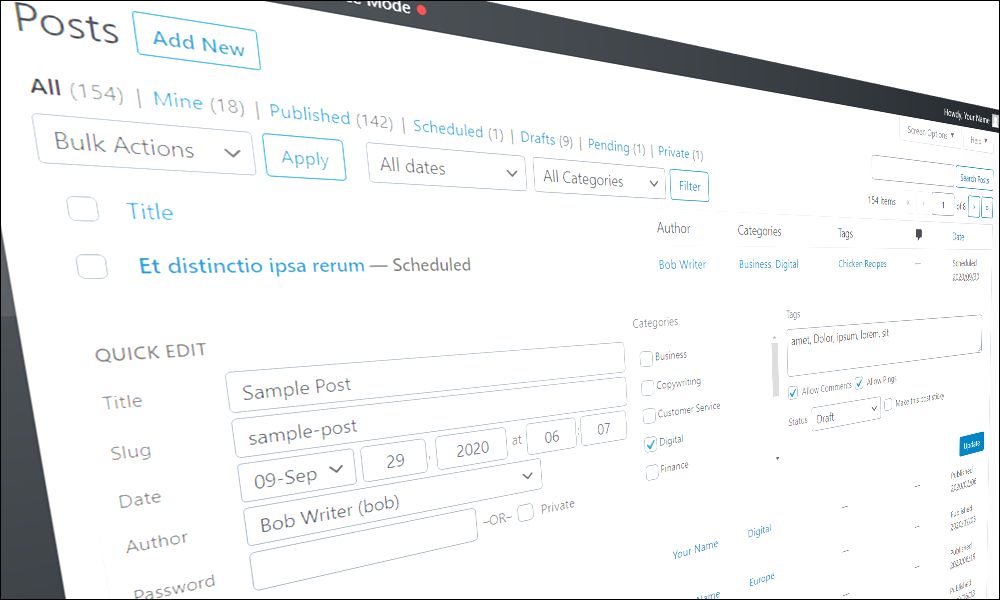
***
Updated: July 5th, 2024
